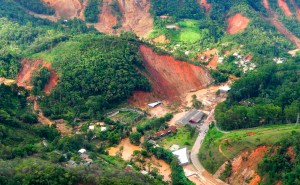 Residents of Brisbane, Australia must have woke up Thursday morning with at least some sense of relief. The swollen Brisbane River that runs through the nation’s third largest city did not reach the catastrophic levels as they were predicted to overnight. With at least 25 dead and a dozen still missing, Australia did not face an easy day, to be sure, but many were also very likely thankful that even more was not lost.
Residents of Brisbane, Australia must have woke up Thursday morning with at least some sense of relief. The swollen Brisbane River that runs through the nation’s third largest city did not reach the catastrophic levels as they were predicted to overnight. With at least 25 dead and a dozen still missing, Australia did not face an easy day, to be sure, but many were also very likely thankful that even more was not lost.
Across the globe, residents of mountainous municipality of Teresopolis in Rio de Janeiro state woke up to their own bad news. At least 146 people are reported to have been killed there after heavy rains, flooding and landslides hit the area on Wednesday. It’s been raining non-stop in the region since the new year, but in the last 24 hours, the overall death toll in the states of Rio de Janeiro and Sao Paolo has jumped to at least 335, according to BBC.
That, unfortunately, is not the end of it.
Relentless rains in recent days have also taken their toll on the east coast of Sri Lanka, an impoverished coastal area still recovering from decades of civil war and the destructive influence of the Asian tsunami of 2004. Over one million people are currently cut off and isolated by the flooding, and 21 have been confirmed dead. Supplies have just started to move into the area today after being cut off from main roads and air for days. In the Philippines, two weeks of heavy rains have led to floods and landslides that have left 42 dead, displaced 400,000 and done an estimated $23 million worth of damage to agriculture and infrastructure.
It not insignificant that most of these locations suffering through these extraordinary weather events today have been through other crippling natural disasters in the recent past. Two days ago, I wrote here about the decade-long drought that until recently the Toowoomba area outside Brisbane had been grappling with. The east coast of Sri Lanka, which I visited after the Asian tsunami in 2005, was battered by the waves of that event, and in 2009, after being hit by Typhoon Ketsana, a woefully prepared Manila saw the worst flooding in its modern history, in which some 250 people were killed and hundreds of thousands were displaced.
As global temperatures rise (in case you missed BW’s post yesterday, NOAA just announced 2010 was tied with 2005 as the warmest year on record), changes in the atmosphere will likely continue to exacerbate yearly weather events like the Asian monsoon and drought, as well as weather patterns like El Nino and La Nina. On a hotter planet, more water evaporates from the land and the ocean, making droughts worse while at the same time sending more moisture into the atmosphere that can lead to more dramatic weather events. As a result, according to the IPCC, “widespread increases in heavy precipitation events have been observed, even in places where total amounts have decreased” — perhaps like places such as Toowoomba, who just three years ago were looking to cloud seeding to save their withering crops. (Read about climate change and this summer’s floods in Asia.) At the same time, rising sea levels will continue to make low-lying places like Sri Lanka, the Andamans, and other nations that were so brutally affected by the 2005 tsunami ever more vulnerable to the kind of seismic activity that triggered it.
We are already seeing the same places getting hit. What will it take to start making sure that these pre-disposed corners of the planet don’t continue to lose so many lives? That’s an easier task for some countries than for others, depending on the nations’ resources or simply the number of people living in them. One of the wide and depressing realities about the climate shift is that it is already disproportionately affecting those who can protect themselves against it the least. If it works, the Green Climate Fund that the international community agreed to at Cancun this year will help, but individual governments, even ones strapped for cash, are going to have to figure out a way for their citizens to continue to live safely in places that are getting less and less safe.


